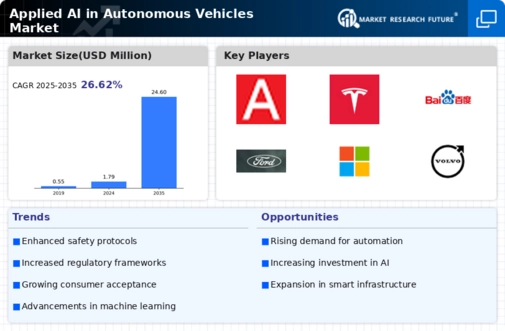Market Growth Projections
The Global Applied AI in Autonomous Vehicles Market Industry is poised for substantial growth, with projections indicating a market value of 1.79 USD Billion in 2024 and an anticipated increase to 24.6 USD Billion by 2035. This growth trajectory suggests a compound annual growth rate of 26.89% from 2025 to 2035, reflecting the increasing integration of AI technologies in autonomous vehicles. Factors such as technological advancements, regulatory support, and rising consumer demand are likely to contribute to this expansion. The market's evolution is expected to reshape the transportation landscape, offering new opportunities for innovation and investment.
Technological Advancements in AI
The rapid evolution of artificial intelligence technologies is a primary driver for the Global Applied AI in Autonomous Vehicles Market Industry. Innovations in machine learning, computer vision, and sensor technologies enhance vehicle perception and decision-making capabilities. For instance, advancements in deep learning algorithms enable vehicles to interpret complex environments more accurately. This technological progression is expected to contribute significantly to the market's growth, with projections indicating a market value of 1.79 USD Billion in 2024. As these technologies mature, they are likely to facilitate the development of safer and more efficient autonomous vehicles, thereby attracting investment and consumer interest.
Consumer Acceptance and Awareness
Consumer acceptance and awareness of autonomous vehicle technologies are pivotal in shaping the Global Applied AI in Autonomous Vehicles Market Industry. As public understanding of AI and its benefits grows, so does the willingness to adopt autonomous vehicles. Educational campaigns and successful pilot programs have begun to demystify these technologies, fostering a more favorable perception among potential users. This increasing acceptance is likely to drive market growth, with projections indicating a market size of 24.6 USD Billion by 2035. As consumers become more informed about the safety and efficiency of autonomous vehicles, their adoption rates may rise significantly.
Increasing Demand for Safety Features
The growing emphasis on safety in transportation is a significant driver for the Global Applied AI in Autonomous Vehicles Market Industry. Consumers and manufacturers alike are increasingly prioritizing advanced safety features, such as collision avoidance systems and automated emergency braking. These features, powered by AI technologies, are designed to reduce accidents and enhance overall road safety. As a result, the demand for autonomous vehicles equipped with such capabilities is likely to surge. This trend aligns with the projected compound annual growth rate of 26.89% from 2025 to 2035, reflecting the market's potential to address safety concerns while promoting the adoption of autonomous driving solutions.
Government Initiatives and Regulations
Government policies and regulations play a crucial role in shaping the Global Applied AI in Autonomous Vehicles Market Industry. Many countries are actively promoting the adoption of autonomous vehicles through supportive legislation and funding for research and development. For example, the United States has established guidelines for testing autonomous vehicles on public roads, which encourages innovation and investment in this sector. As regulatory frameworks evolve, they are expected to create a conducive environment for the growth of the market, potentially leading to a market size of 24.6 USD Billion by 2035. Such initiatives may also enhance public trust in autonomous technologies.
Rising Urbanization and Traffic Congestion
Urbanization and the accompanying traffic congestion are driving the demand for autonomous vehicles, thereby influencing the Global Applied AI in Autonomous Vehicles Market Industry. As more people migrate to urban areas, the need for efficient transportation solutions becomes increasingly pressing. Autonomous vehicles offer the potential to alleviate congestion through optimized traffic management and reduced reliance on personal vehicles. This shift is expected to contribute to the market's growth, as cities seek innovative solutions to improve mobility. The anticipated market value of 1.79 USD Billion in 2024 reflects the urgency of addressing urban transportation challenges through AI-driven technologies.






















Leave a Comment